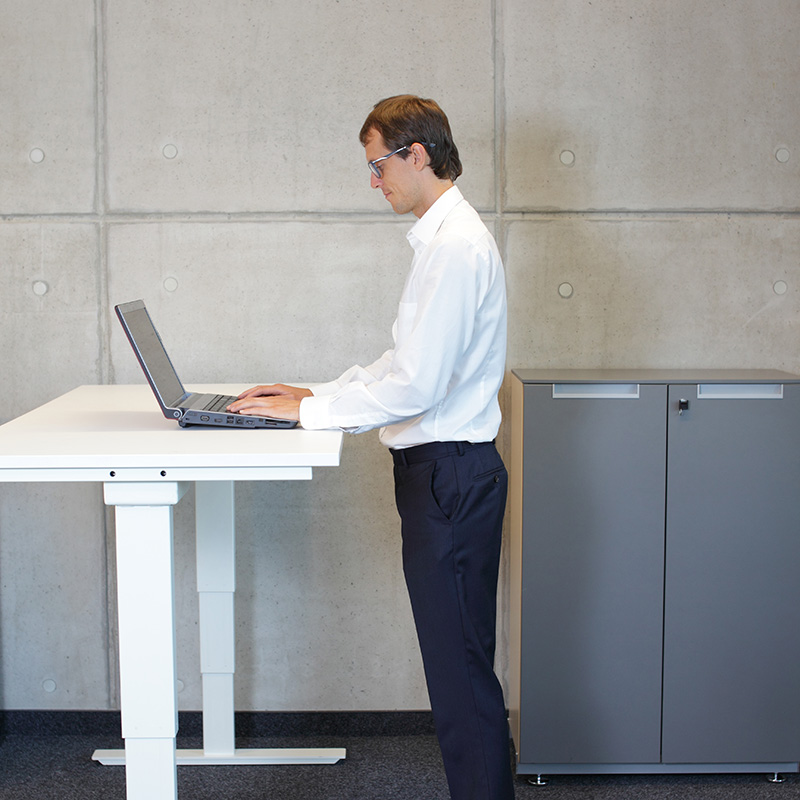
The idea that sitting can be harmful seems ridiculous at first thought. Sitting is a default human body posture, and when people work, socialize, study or travel, they often do so in a seated position. It’s second nature. However, that doesn’t mean sitting is harmless. It’s like eating — necessary, but harmful if you do too much of it. Unfortunately, sitting too much, is now at an all-time high. Over half of the average person’s day is spent sitting, doing things like driving, working at a desk or watching television. In fact, the typical office worker may spend up to a whopping 15 hours per day sitting. To battle this trend, standing desks are becoming increasingly more popular.
What Is a Standing Desk?
A standing desk, also called a stand-up desk or sit-stand desk, is basically a desk that allows you to stand up comfortably while working. Many versions are adjustable, so that you can change the height of the desk to accommodate a person’s height and alternate between sitting and standing. Although research is still in early stages, it does appear that using a standing desk can have impressive benefits for health. At the very least, using this type of desk can partly negate the harmful effects of sitting too much.
Here are 7 health benefits of using a standing desk, that are supported by science.
-
Standing Lowers Your Risk of Weight Gain and Obesity
While exercise is the most effective way to burn calories quickly, simply choosing to stand instead of sitting can also be beneficial. In fact, when compared to an afternoon of sedentary work, an equal amount of time spent standing has been shown to burn over 170 additional calories. That’s almost 1000 extra calories burned each week from simply standing at your desk each afternoon.
-
Using a Standing Desk May Lower Blood Sugar Levels
In a small study of 10 office workers, standing for 180 minutes after lunch reduced the blood sugar spike by 43% compared to sitting for the same amount of time. Another study involving 23 office workers found that alternating between standing and sitting every 30 minutes throughout the workday reduced blood sugar spikes by 11.1% on average.
-
Standing May Lower Your Risk of Heart Disease
Scientists have developed a much greater understanding of the effects of sitting on heart health, with prolonged sedentary time thought to increase the risk of heart disease by up to 147%. It is so harmful that even an hour of intense exercise may not make up for the negative effects of an entire day spent sitting.
-
Standing Desks Appear to Reduce Back Pain
Back pain is one of the most common complaints of office workers who sit all day. To determine if standing desks could improve this, several studies have been done on employees with long-term back pain. In one study, participants reported up to a 32% improvement in lower back pain after several weeks of using standing desks. Another study published by the CDC found that use of a sit-stand desk reduced upper back and neck pain by 54% after just 4 weeks. Additionally, removal of the sit-stand desks reversed some of those improvements within a 2-week period.
-
Standing Desks Help Improve Mood and Energy Levels
Standing desks appear to have a positive influence on overall well-being. In one 7-week study, participants using standing desks reported less stress and fatigue than those who remained seated the entire work day. Additionally, 87% of those using standing desks reported increased vigor and energy throughout the day. Upon returning to their old desks, overall moods reverted to their original levels. These findings align with broader research on sitting and mental health, which links sedentary time with an increased risk of both depression and anxiety.
-
Standing Desks May Even Boost Productivity
A common concern about standing desks is that they hinder daily tasks, such as typing. While standing each afternoon may take some getting used to, standing desks appear to have no significant impact on typical work tasks. In a study of 60 young office employees, using a standing desk for 4 hours each day had no impact on characters typed per minute or typing errors. Considering that standing improves mood and energy as well, using a standing desk is more likely to boost productivity rather than hinder it.
-
Standing More May Help You Live Longer
Studies have found a strong link between increased sitting time and early death. This is not surprising given the strong association between sedentary time, type 2 diabetes and heart disease. In fact, a review of 18 studies found those who sit the most are at a 49% greater risk of dying early than those who sit the least. Another study estimated that reducing sitting time to 3 hours per day would raise the average American’s life expectancy by 2 years. While these observational studies do not prove cause and effect, the weight of evidence indicates standing more often could help lengthen our lifespan.
It’s Time to Take a Stand
Reducing sedentary time can improve physical, metabolic and even mental health. This is why sitting less and standing more is such an important lifestyle change. My next article will more specifically address neck and back pain with sitting.

